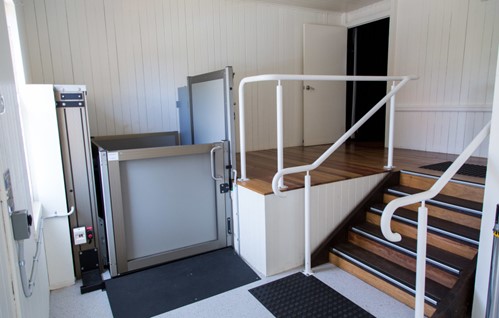Platform lifts
A platform lift can support you with getting into, out of and between levels of your home. Other options may include hand rails or ramps. Depending on your situation, Disability Support Services may be able to help with funding for these modifications.
On this page
What is a platform lift?
A platform lift has a flat surface, or platform, to hold people or objects. The lift moves the platform up and down from the ground level. The lift is made of galvanised steel and is designed for outdoor use.
A platform lift can be used where there is not enough space or the ground is too steep for a ramp.
The lift must have a permanent concrete pad as a base and a separate power supply. It needs regular maintenance to operate safely.

Example of a low-rise platform lift. (Photo by Brisbane City Council, used under a Creative Commons licence.)
Is a platform lift the best option for you?
For the entrance to your home to work the best it can for you, think about how you get around, what your disability needs are and what your home is like.
Here are some questions to consider:
- Which entrance do you usually use at your home? Is this the easiest or most practical way to get in and out of your home? Are you able to get to that entrance easily from the most reasonable place to park your car?
- Does the design of the entrance or the slope of the land make it difficult to install a ramp?
- Is there enough space to install a lift?
- Will other people need to use the existing steps to get in and out of your home?
- Will you be operating or travelling on the platform lift by yourself or will you need someone else on the lift to assist you?
- Will you be using a manual or power wheelchair on the platform lift? (The weight of a wheelchair will help determine what type of lift you need.)
- How long do you think you might be living in your present home – will you be there for at least two years?
What to look for when choosing a platform lift
- Platform size: Does someone else need to travel on the lift with you?
- Lifting capacity: The lift's carrying weight limit is important, especially if you use a power wheelchair, which is heavier than a manual wheelchair.
- Placement of operating controls.
- If a remote control or call station (to 'call' the lift from the bottom or top position) is needed.
Sometimes modifying your home may not be the best or only option for you. For example, if modifying your home is not an option, you may be able to find another home that suits your needs better.
Getting a platform lift
Contact a Disability Support Services Equipment and Modification Service (EMS) qualified housing assessor to help you work out what type of platform lift best for you. They will help you work out the most cost-effective option for your needs and if you can get funding support from DSS.
Your doctor can refer you to an EMS qualified housing assessor or you can refer yourself through local hospital community health services.
You may also choose to organise and pay for the platform lift yourself.
Repairs and maintenance
Platform lifts need regular maintenance and cleaning to keep them slip-resistant and in good working order.
Low-rise platform lifts (up to 1.5 metres high) are available on long-term loan from Disability Support Services. You must return the lift when it is no longer needed. DSS covers the costs of all repairs, maintenance and installation or removal of any borrowed low-rise platform lift.
This work is completed by DSS equipment providers:
- Accessable (for people living in Auckland or Northland)
- Enable New Zealand (for people living in the rest of New Zealand).
The home-owner is responsible for all costs associated with maintaining a platform lift that is over 1.5 metres high, including any repairs, maintenance, installation, replacement or removal. This type of platform lift is part of the home-owner's property.
Find out more about platform lifts:
If you live in Auckland or Northland, contact Accessable by
- Freephone 0508 001 002
- Email info@accessable.co.nz
If you live anywhere else in New Zealand, contact Enable New Zealand
- Freephone 0800 17 1981
- Email enable@enable.co.nz